Gawker Unsolicited: Spell my Damn Name Right, and Other Hot Tips for Agents.
Somebody give me a machete. I can’t get through all the layers of irony here.
Never underestimate the commercial value of mental illness.

Gawker Unsolicited: Spell my Damn Name Right, and Other Hot Tips for Agents.
Somebody give me a machete. I can’t get through all the layers of irony here.
It’s been clear for months that it will be a not-so-merry holiday season for publishers, but at least one house has gone so far as to halt acquisitions. PW has learned that Houghton Mifflin Harcourt has asked its editors to stop buying books. […] Another agent who had also heard about the no-acquisitions policy at HMH called the move “very scary” and said it’s indicative of an industry climate worse than any he’s ever seen.
Predictions:
Yeah, it’s depressing, but A) everybody’s having a hard time, so boo hoo at you too, publishing and B) everything is cyclical.
Quite frankly, the economic downturn and the rise of the ebook couldn’t be timed better. You build up the low-cost or free alternative in the downswing (coupled with instant gratification), something people can afford and are open to, then you see it explode once the upswing begins.
 Dead tree books will NOT be a thing of the past (knock on wood), but the smart publishers and booksellers will find cheaper alternatives to bring those to market too. If you want to survive after an economic downturn, you must start thinking in the long-term instead of the short-term; you sure as heck aren’t making any money now, so figure out how to make money when everybody has some again.
Dead tree books will NOT be a thing of the past (knock on wood), but the smart publishers and booksellers will find cheaper alternatives to bring those to market too. If you want to survive after an economic downturn, you must start thinking in the long-term instead of the short-term; you sure as heck aren’t making any money now, so figure out how to make money when everybody has some again.
Pssst, publishers and booksellers:
It’s called the Espresso.
In kiosks.
At Wal-Mart, Target, and smack DAB in the middle of your chain or independent bookstore.
So I saw this in Publisher’s Weekly online yesterday and bookmarked it to blog about, but then Janet Reid beat me to the punch.
Recently, funny things have been happening in my slush pile. I find myself receiving well-written, correctly formatted, professional-looking query letters from bad writers. Imagine my chagrin: one minute I’m intrigued by a smoothly crafted query letter, the next I’m staring down at a crackpot writing sample.
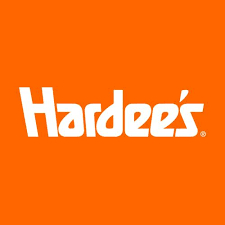 I wondered how long this would take.
I wondered how long this would take.
I will always and forever remember a story my dad told about Hardee’s barbecue sauce and a taste-tester he met. The point wasn’t to make a standout barbecue sauce. The point was to make the barbecue sauce as inoffensive as possible to the largest number of people.
So I’ll call it the Hardee’s BBQ Sauce Query.
One comment on Janet Reid’s blog summed up my thoughts quite nicely:
Post Summary: In the 21st Century, people can Google query on how to do something and find carefully composed instructions. Thus, the prior vetting process is no long efficient for the Literary Agent.
My 2 Cents: Awesome. Adjust or die.
Thank Mike Cane for this rant.
I’ve read a few self-pubbed books lately. None of them were egregiously horrible in the design department and a couple of them were even fairly decent. And frankly, after I converted them to digital and put them on my ebook reader, it wasn’t an issue at all. But let me take the opportunity today to piss off everybody right up front and then we’ll get to the good stuff.
Design, people. Design is the first reason independent publishing gets no respect. If a reader can’t get past the design, doesn’t matter how good the writing is or isn’t.
I’m not going to worry about discussing cover art today, because, well, I can’t speak. I winged that and after about a year and sixteen different covers, I had enough skills to put this together:
So let’s talk about interiors, shall we? In this I have a wee bit of knowledge, but mostly it comes from J-school.
In my opinion, there are a few basics that should be fairly commonsensical but I’ve seen violated as of late:
In my case, I had a 283,000-word book. I wasn’t going to be able to mess with font sizes much and still fit it all in one spine, which meant I had to do a couple of things I wasn’t happy about, but won’t do on books any shorter. One thing was having to make the font 11 pt. Because in Adobe Jenson, that’s really really really small; on the other hand, the line spacing is 14 pt, which, according to some typography books I’ve read, is a good ratio and I must say my eyeballs agree. The other thing was:
Okay, so here’s an example from The Proviso:
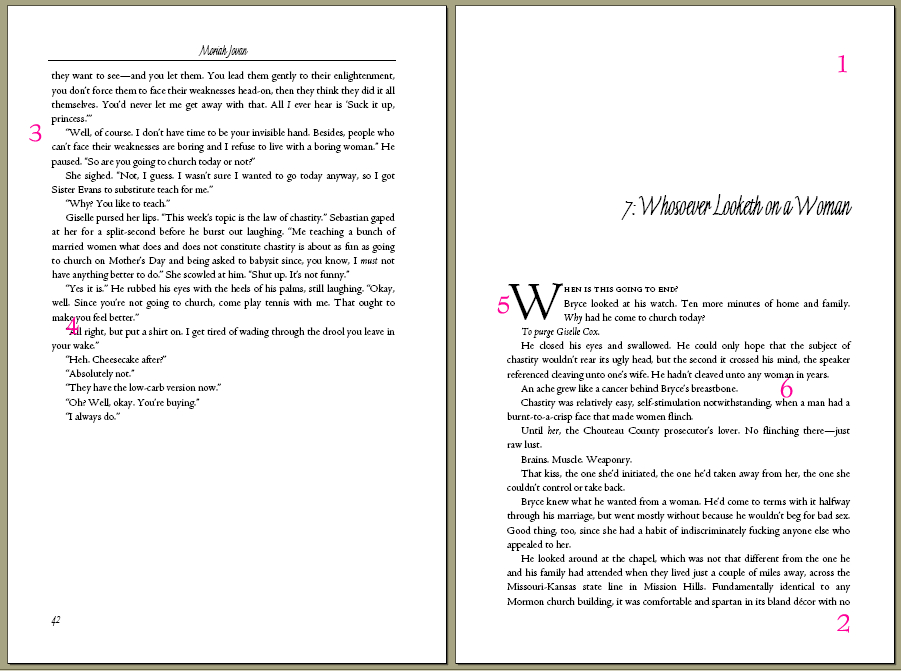
Let’s break it down.
So what’s my point?
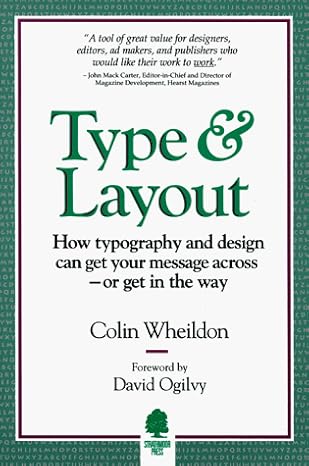 If you are going to try to do these things yourself, learn what makes human eyeballs happy. Read the books. The one I lived and breathed by was this one:
If you are going to try to do these things yourself, learn what makes human eyeballs happy. Read the books. The one I lived and breathed by was this one:
Practice. Experiment. Study the way other books are designed (especially the high-end ones). Notice details. Take notes. Don’t be afraid to throw out your pet specs (the same way you shouldn’t be afraid to throw out your words that don’t work).
Independent publishing is a business just like any other business that sells goods to merchants, which makes it difficult enough for us in an industry that doesn’t do business that way and has a vested interest in keeping the status quo. But you know what? If the last week of handselling has taught me anything, it’s that the readers don’t care who published your book—unless it looks like an unprofessional job.
If they take one look at the book and ask to see it, read the back copy, then flip open the pages to read a little bit, and then whip out their checkbook (especially for a book this expensive), then you’ve done something right. If they aren’t intrigued enough to make it to the back copy, and then the first couple of pages, all the good writing in the world isn’t going to help you. They won’t know why they don’t like looking at it and they’ll care even less, but they will know they just don’t want to look at it.
Bottom line: Once you’re finished with the story inside, forget about it and concentrate on the visuals. The book is the art. It all works together in a symbiotic fashion. Don’t believe me? Ask all those authors whose publishers killed their sales straight out of the gate with a bad cover and bad back copy.
“We don’t know where to put it.”
I do. Right in the readers’ hands.
 I’ve had a lot on my mind lately that I haven’t been able to untangle, much less unpack on an issue-by-issue basis. What are they?
I’ve had a lot on my mind lately that I haven’t been able to untangle, much less unpack on an issue-by-issue basis. What are they?
But a couple of posts on Nathan Bransford’s blog yesterday sorted at least one issue out for me, which is my firm belief that whether or not independent publishing becomes as accepted independent filmmaking and independent music making, it was the right choice for me. And I’m going to come back to that Espresso Book Machine thing because it’s tres important.
Which leads me to a post Mike Cane made recently about self-pubbing and an author’s inability to do it all, yet tries because he wants to save money. He’s right overall, but I learned long ago that creative types in one discipline are drawn to other disciplines and have the ability to do those well, too. What they are, though … that I can’t say. So that’s going to be my jumping off point for today’s Jack Handey.
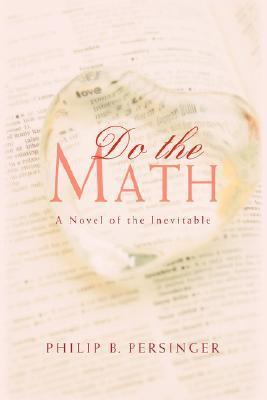 Do the Math
Do the Math
by Philip B. Persinger 💔
published by iUniverse
I read a review of this book that pissed me off, but the blurb looked interesting and so I went forth to iUniverse (yes, it’s independently published) to purchase the ebook. I will spare you the nightmare of actually getting the book, but iUniverse? Bite me. Fortunately, the author came through for me when I copied him on my bitchmail to iUniverse (which they still haven’t responded to). Anyway, he got me a print copy of his book posthaste and so I was a fan on that basis alone.
Here’s the blurb:
What could be worse than losing the love of your life? Getting her back!
William Teale is a brilliant professor of mathematics. His theory of inevitability posits that any human action, no matter how insignificant, might result in a disproportionately huge calamity.
His wife, Virginia “Faye” Warner, is a world-famous romance novelist who specializes in reuniting soul mates after a tragic and prolonged separation. According to her math, “one past and two hearts plus one love equals four-ever.” The Teale-Warner marriage is a thing of geometric and artistic perfection, a melding of the heart and the brain-amour and algebra.
But when Faye’s ghostwriter suffers a nervous breakdown and shakes all the arrows out of Cupid’s quiver, Faye reintroduces her husband to love. Unfortunately, it’s not with herself, but with the woman William had loved and lost years ago. Love is about to clash with inevitability, and it’s unclear which will emerge victorious.
Told in the off-beat voice of William’s graduate intern, Roger, Do the Math reveals the curious relationship between logic and love and the delightful consequences of taking a chance.
Only one bad point and it’s technical: The funky paragraph breaks in dialog. Oh, I don’t mean the looooong monologues that have to be broken, but, for example:
“Her home away from home,” he answered. “Room 407. New Coventry Medical Center. Only the best.”
“By the way,” he added as he picked up Claire’s drink and toasted me with it. “You did very well tonight, Roger.”
That unnecessary split happened enough that it was annoying, but certainly not enough to diminish the overall fantasticity of this novel. If you ever needed a posterbook for the validity of self-publishing, this is it.
And one aside, which I don’t know if it was tongue-in-cheek or not. A vague reference is made to the movie Poltergeist, but the story is set in 1978 and that movie didn’t come out until 1982. I could see how that could go either way, so I’m giving the author the benefit of the doubt.
This is the story of 50-year-old professor of mathematics William Teale and Virginia, his romance-novel-writer wife and Claire, Teale’s lost love from 25 years ago. It’s told from the point of view of his 25-year-old intern, Roger, in first person. And oh, it takes place in 1978. Did I say that already?
This book’s kinda sorta billed as a romance. I think. I’m not really sure. And I don’t really know what it is anyway except hilarious. I know it’s supposed to be poignant and bittersweet. I know it’s supposed to be about Teale’s relationship with his wife and his lost love. Really, I do know that.
But what you have to know going in is that I have an eccentric sense of humor and a wee bit of a crush on higher math. Can’t add or subtract without a calculator (multiplication and long division are simply out of the question) and I really just don’t care for discrete math much, but after some struggle and time, I’m a fair hand at simpler calculus. It’s like the bad boy you just want to take home and try to tame.
Okay, so what that’s got to do with the price of tea in China is this: If you don’t get the math jokes, it’s okay. It’s still funny. If you do, it’s ROFLMAO funny. The author conflates mathematics and romance in such a bizarre way I can’t help but chortle just thinking about it. For instance, Teale tries to figure out what to do about his problem using set theory in a discussion with Roger:
“It’s about balancing the quality of the empty set against one with two elements,” I started out. “That just doesn’t make sense.”
“No, it doesn’t,” he said.
Relieved by that concession, I followed up.
“Then how can a set of two elements be qualitatively equivalent to an empty set?”
He smiled wearily. “Unexplored territory, isn’t it?”
He thought a moment longer. “It’s the wasteland,” he said. “We understand the null set. There’s nothing there. But a set of two elements which has no connection, or, if connected, no contiguousness, that is, ultimately a set that is in and of itself empty, isn’t it?”
In other words, using set theory, Teale equates his relationship with his wife (two elements in one set that are disconnected) to a set with nothing in it.
All the little oddball characters that populate a college campus/faculty/town are fondly drawn and you can immediately find the equivalents of these people in the memories of your own college experience. All the subplots come together nicely in one tight, tidy little knot at the end (although I’ll admit I knew where one of them was going on page 23, and sure enough).
Now, about that “romance novels are just a formula” business: That is repeated ad nauseam throughout the tale, but funny enough, even though they spend valuable computer time (vacuum tubes! keypunch cards!) trying to figure it out, they read from a how-to-write-romance manual and follow it strictly, and yet … they never manage to figure it out, disproving their own premise that there’s a real formula to it.
I had no problem with this facet for three reasons: (1) Though all the characters (including the romance novel writer and her ghostwriter) think this, it doesn’t seem to be thought of as a bad thing; it’s simply a fact of their life and needs to be adhered to as any other product specification, as they’re up against a deadline, and (2) This is set in 1978, remember. The specifications outlined are, to the best of my recollection, exactly how romances were written in the late ’70s, so I can’t really go throwing stones at fact (or at least my perception of fact), and (3) For all the “formula” talk, it was still respectful of the genre and its fans.
Some passages that made me howl (and wake up the Tax Deducations) got their pages dog-eared. (The horrors!) Examples (although I must warn you that my sense of humor is a bit, ah, weird, and these are somewhat out of context so they might not translate):
[Sample from a technical writer for a nuclear reactor handbook applying for the job of a romance novelist ghostwriter]:
“ … pump type can be determined by identifying flange at top of housing. Inductive cooling pump has a rigid pressure release vent hanging down perpendicularly on flange centerline. Whereas action release coil pump is unique because of the two nipples protruding from either side directly above the emergency bleed valve.”
and
“A warning. The manifold might be hot. Use caution when sliding the spanner between the opened blades, as there is a danger of electrical arcing … It might be necessary to remove the probe from the main sheath and reinsert with proper lubrication … If vibration continues, apply appropriate torque to the uppermost junction point until release is achieved … ”
[Romance novelist] closed the booklet with a rude snap.
“There has been a terrible misunderstanding here.”
“I’m sorry?” said Claire.
“This seems so—how should I put it? Technical.”
Even though it is in no real way similar, it vaguely reminded me of Neal Stephenson’s The Big U. Loved the premise, loved the voice, loved the characters and the humor is dry enough to make you beg for water.
And, oh, the author didn’t assume the reader would be 5 and need everything explained.
DISCLAIMER TO CLEAR UP SOME CONFUSION:
This is NOT about my book.
This is about SOMEONE ELSE’S book.
The Mysterious They say that contemporary romance (you know, without vampires, shapeshifters, werebeasts, ghosts, phantoms, and mimes) is dead. Yeah, I know. ’Swhy I wrote one. Sorta.
I have a very low tolerance for romantic suspense, paranormal romance makes me roll my eyes, and m/m doesn’t float my boat (although I can tolerate it in menage). Give me alternate reality or steampunk or post-apocalyptic or anything that could happen, and I’m good to go. Better yet, give me contemporary.
Okay, so in doing my part to save the whales–uh, er, straight heterosexual contemporary romance (because “straight contemporary” is taking on a whole new connotation these days), I’m going to plug the competition: Flat Out Sexy by Erin McCarthy, as reviewed on Dear Author.
Obviously, I haven’t read this puppy, but I plan to when it comes out and so I’m going to plug it in advance. Why?
I’m dying for a straight contemporary that’s more than 150 pages long (i.e., category length). That’s a snack (and besides, I stocked up on early ’80s Carole Mortimer Harlequin Presents at the thrift store Saturday). Okay, it’s 304 pages, not exactly a feast, but it’ll do in a pinch. I want to support straight heterosexual contemporary the way I want to support independent publishing.
Plus, the heroine is a cougar (not the werecat kind) and we could all use a few more cougars in romance.
Over on Teleread, there’s a new blog post today about ebooks being fertile for annotation. I envision this somewhat like a post littered with Wikipedia links to explain things so that the reading audience who doesn’t know what he’s talking about can go get a little primer, and the part of the audience that does know won’t have its reading flow interrupted.
I could have (and still could at any point in the future) litter The Proviso with references and annotations embedded in the ebook editions, but my question is this:
If you had an ebook reader (or if you HAVE an ebook reader), how do you think you’d like such a thing?
On the ebook front, nothing much to report except the iLiad just released a new thingymajig that’s not getting rave reviews. And the Kindle’s not coming out in the UK this year.
On the publishing front, The Mysterious They say that if you’re a midlister or a new author—or an agent specializing in such—y’all are just SOL ’cause the PTBs at major houses are tightening their belts (which means either the smaller houses will be, too or they’ll step in to take up the slack and make a mark).
Yeah. I don’t have that problem.
Oh, one more thing. As a reader, I have a suggestion for you e-publishers: Put the blurb of the book on the first page. That way I haven’t forgotten what the book is about when I open up my ebook reader and see titles and author names. I’m terribly forgetful and have no wish to dive into a book I don’t know what it’s about. Yeah, I downloaded it so it must have intrigued me but now I don’t know why. With my print books, I always go to the blurb to figure out what I want to read next, but obviously, there is no back-of-book on an ebook.
And by the way, we did put The Proviso’s blurb in the front for that very reason.
I’ve referenced agent Lori Perkins before because she’s not constantly talking about how to write a better query or cheerleading constantly. YOU!CAN!DO!IT! YES!YOU!CAN! as if the odds of being picked up by an agent and, in turn, a publishing house aren’t astronomical. (And for a pittance, even.)
Anyhoo, today’s LoriPost What Does This Economic Downturn Mean For Writers? is even more sobering for those of you still laboring in the shadow of the faint hope of The Call:
These publishing companies work so far in advance, that when they decide to slow down acquisitions, they can literally just stop buying for 6 or 9 months. And that’s what I predict will happen here.
And yet the news with epublishing is exciting, the industry vibrant and growing, niche markets blossoming as readers find what they want to read that isn’t the SSDD the gatekeepers must buy to maintain their bottom line.
Perhaps it’s time for more writers to shake the dust of [sneer] self-publishing (otherwise more properly known as independent publishing) off their feet and make like the shoppers at Home Depot: Do it yourself. Yeah, it’ll take some time, quite a bit of money if you do it right (e.g. and *ahem* avoid the more egregious vanity/subsidy presses, pay an editor, hire a graphic designer), a complete 180-degree shift in your thinking and attitude, and a helluva lot of hard work (details! O, the details!) but you’re in control.
Freedom, man.
My mother once asked me, “Why are you basing your goals on decisions someone else has to make?”
This and that, in no particular order. Mostly stuff I forgot in the ePub post or didn’t know while I was writing it or changed as soon as I hit the “publish” button.
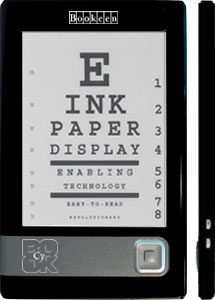 BOOKEEN CYBOOK. I briefly mentioned this in the ePub post, but forgot to say that this is one that’s caught my attention more than a few times. It’s just that it gets overshadowed by the Biggies and I forget about it. eInk (therefore, no backlight–but you knew that), supports PDFs (don’t know about reflow), plays mp3s. Also supports Mobipocket, HTML, TXT, and PalmDoc. It runs $379, which is a bit rich for my blood.
BOOKEEN CYBOOK. I briefly mentioned this in the ePub post, but forgot to say that this is one that’s caught my attention more than a few times. It’s just that it gets overshadowed by the Biggies and I forget about it. eInk (therefore, no backlight–but you knew that), supports PDFs (don’t know about reflow), plays mp3s. Also supports Mobipocket, HTML, TXT, and PalmDoc. It runs $379, which is a bit rich for my blood.
BEBOOK. There’s a new little kid in town. According to MobileRead forums, this puppy’s got 30k machines in circulation (which I have no idea what that really means). At $349, you can add it to the eInk contenders.
BOOKS ON BOARD and DIESEL EBOOKS. I know I talk about Fictionwise a lot, but more and more I find myself going to booksonboard.com and diesel-ebooks.com just because their formats are easier to follow and I can find stuff more easily. Fictionwise is a nightmare for my poor ADD. So, hey, Fictionwise. Do something about your web design, because you’re about to lose a customer.

Coming to an Australian bookstore near you. Am I the only one who can visualize this beast in the middle of Wal-Mart and Target, Sams Club and Costco? I mean, this isn’t new news; the concept has been around for a while, but the machines are expensive.
Still, I’d think Barnes & Noble and Borders would find this to be worthy of early adoption, if only to reduce their stores’ square footage and associated costs. Why are you still sitting in that small box? Your cheese moved.
[Okay, okay, to be fair, PersonaNonData reports that they’re steadily rolling out in the US.]
As ebookie as I am, I’m excited about this thing Time called an “ATM for books.” Paper is still my first love, to stroke and fondle, to smell and behold. Uhm, paper prØn?
STANZA. I’ve been hearing a lot lately about this ebook reading software which runs (built expressly for? I don’t know) the ePub format. After preliminary perusal, we at B10 find this pertinent to us in that it offers ways to convert text to the ePub format and an iPhone/iTouch app to read ebooks on those devices. According to the website, it is also:
… the first program that has a built-in export feature especially for the Amazon Kindle. Your PDFs, Word documents, and other eBooks can all be exported to the Kindle’s native format and copied over to the device using a USB cable.
However, before we get our hopes up, Apple may blackball Stanza the way it’s blackballed Podcaster. Still, Stanza 1.4 (newest version) is now up in the iApps store.
So along with Stanza, the current state of publishing, the slow (in my opinion) early adoption of the Espresso by outlets such as Barnes & Noble and Borders, please simply add in the requisite anti-DRM rant–
Just how long until commercial publishers start using Stanza to sell and distribute their wares as nonDRMed ePub? And how will the terms compare to those of Amazon and others? (From the Teleread article linked above.)
This is where you start wondering where the Greedy Bastards went. Ban? Ignore? Flee? No! Embrace! Embracement = mo’ money. Where’s Gordon Gekko when you need him?
I haven’t read Stephenie Meyer’s Breaking Dawn. I read Twilight and while I like cotton candy, I can only take so much. Like, one cone every 10 years or so or.
By now I’m sure everyone’s heard about the backlash against what is reputed to be the shoddy workmanship of Breaking Dawn and the push to return it to the bookstores after having read it. Mind you, the complaints ranged from the fact that Meyer tore her own world’s rules asunder to the poor editing job (i.e., grammar, spelling, typos). I found more than a few of those in Twilight and it bugged me then that a major publisher would release it like that. It looked so [sneer] vanity published.
I’ve heard ad nauseam about the gatekeepers, the agents and the editors, whose self-appointed Prime Directive is to keep out the unwashed masses of illiteracy who think they have a bestseller in them somewhere. They are there to not only 1) screen out the dreck and vet work that is potentially money-making, but once that is finished, to 2) put out a product that is well edited, well designed, and doesn’t look like it’s [sneer] vanity published.
Well, with Twilight, they did the first part right: They found a piece that would make money.
With the second part, they dropped the ball (especially with regard to Breaking Dawn) and Meyer ended up being put on the spot for a) bad writing, b) violation of her world’s rules, and c) bad editing in all stages.
I think that’s totally unfair.
I’ve been thinking about one particular Breaking Dawn post/thread on Dear Author for over a month now, wherein the commonly held die-hard fan opinion [that Meyer wrote by whimsy alone (putting forethought and craft aside)] was reiterated by author K.Z. Snow:
What’s so irksome is this: Meyer seemed to have a serious–and, to me, really appalling–lack of commitment to and respect for the craft. So shoot me for idealizing what we do, but one doesn’t become a writer on a freakin’ whim. I’m not surprised there’s been a degeneration from one book to the next.
and I opined:
I think this is clearly a case of wringing blood out of a turnip by the publisher and editors. They’re the ones who control the channel to the marketplace. If Meyer doesn’t have a commitment to the craft, who’s to blame? Meyer? No. The publisher and editors who facilitated her in that. If she has any thought about “craft” at all, I’d be surprised–and that’s not her fault. She hasn’t been required to to sell a gazillion+1 books.
Nora Roberts disagreed with me:
Yes, it is. Her name’s on the book. It’s her work. […] But it is the author who’s responsible for what’s on the page.
And this comment is what’s had me thinking about this for so long after it’s been done and gone.
Ms. Roberts’s comment is borne out in the fact that Meyer alone was held accountable for what’s widely perceived as shoddy workmanship. Do we know who her editors (content, line, and copy) are? Undoubtedly somebody does, but they aren’t the ones being burned in effigy. I wonder if they got dragged into a meeting to find out why so many die-hard fans took their books back? I wonder if they got sent to Remedial Editing? I wonder if Meyer went back and said, “Hey, why didn’t you do your job? You made me look bad and you’re supposed to make me look good. You’re the gatekeepers.”
She was also responsible for selling those gazillion+1 books and making a helluva lot of money for those gatekeepers, whimsy and shoddy workmanship and all.
Yet why should Meyer bear sole responsibility for what is obviously a case of “Bless her heart. It ain’ her fault; she doan know no better”? Moreover, she doesn’t know she “doan know no better” as evidenced by the fact that she’s trying to defend the book by blaming readers. “They just didn’t get it.” Well, maybe they didn’t, but you don’t say that in public. If you can’t keep from digging yourself into a hole, shut the hell up.
(And ahem, Stephenie. You’re college educated. Could you not have gone through your manuscript to make sure you caught all the typos? Oh, right. That was the copy editor’s job, wasn’t it?)
Meyer’s editors, in looking for a quick buck sooner rather than later, threw Meyer to the wolves. They, as the self-appointed gatekeepers should have done their jobs and when they didn’t, they let her take the fall because, as Ms. Roberts points out, it’s her name on the book.
They also threw the readers and die-hard fans to the wolves—who howled loud, long, and with their checkbooks. Who knows how many die-hard fans felt betrayed who did not take their books back and did not burn them (as some did)?
I have come to no conclusion except that, at this point, I think both Ms. Roberts and I are right. But how can that be? I don’t know, because obviously Meyer was held accountable for it, but she wasn’t the one who enthusiastically put it in the editorial pipeline. I can’t think she had much control over it after that other than galley proofs.
Right now, though, I only have two questions:
Jasmine or honeysuckle, if you’re offering. Lavender and gardenia make my nose itch.
A resident of the Ivory Tower, who apparently called dibs on A’isha (child bride of Muhammed) as her personal and exclusive domain of study and forgot to send the memo, raised a ruckus about a book she didn’t like and managed to get Random House to pull it after the author had been paid her $100k advance and the presses were rolling. I say it’s an academic hatchet job.
PUBLISHERS
I’d like to see new and different in romance. It took Ellora’s Cave and Loose Id and Samhain to break you out into genres you wouldn’t touch before (and no, they’re not all erotica).
I’d like to see you lead the way into e-publishing but again, you didn’t get in gear until the above-mentioned trailblazers kicked your butts. Apparently not even Baen was able to get to you like those three did.
INDEPENDENT BOOKSELLERS
The consignment system of inventory management is, I believe, in its late afternoon and Barnes & Noble CEO Riggio wants to push it into that good night. Agent Richard Curtis (and foresightful creator of e-Reads) points out that it’s not going away–on the dead-tree book brick’n’mortar playground, but, he says,
See, the thing is, I keep getting these great ideas to blog about, but then I get distracted and they don’t gel and I have about 6 half-written posts in my drafts folder that kinda sorta mean something to me now, but not really. Prepare for leftovers, kiddies, because mommy’s tired and she doesn’t want to cook dinner.
Re: ANN HERENDEEN AND PHYLLIDA
This is what’s apparently called “good” gossip. I shall take the liberty of bragging. Read more
TO: LDS Fiction Publishers
FROM: MoJo
RE: Warning labels
Lest you think I was kidding about that warning label thingie I mentioned only about 16 times across various blogs over the weekend’s little dustup, I bring you a way to justify such a practice to yourself: Sales.
My subtitle says, “Religion. Money. Politics. Sex.” Okay, I think I’ve covered them all, but my tag cloud says I’m getting heavy on the religion side, so let’s hit the money for a while.
Over on Teleread, while looking for a post on ePub format (I know I read it the other day and I’ll address that in a future post), I found this gem: Top Ten Self-Publishing Myths. It’s all relevant to me, but I’m not going to post it all here. Copyright, you know. Go read, then come back!
I have a buncha novels on my hard drive that have been sitting around collecting dust since, oh, 1990 some time, I guess. In ’93 I wrote one that got me an agent another that year that got me a contract—before they were shut down (because, according to the rumor at the time [get this] it was making too much money and it had been created to take a loss for tax purposes) (remember Kismet? Anyone? Anyone? Bueller? Bueller?) [dead link]; one in ’95 that got me an early-Saturday-morning phone call from Harlequin to pleasepleaseplease overnight the manuscript; and a fourth novel in ’98 that got me a different agent.
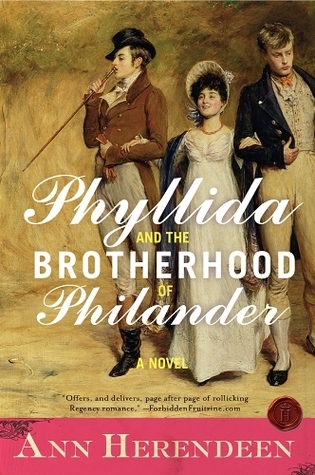 Phyllida and the Brotherhood of Philander
Phyllida and the Brotherhood of Philander
by Ann Herendeen
Yeah, so I’m not really all about the bisexual historical romance (“a man in love with his wife and his boyfriend”), but what I am about is when self-publishing serves its purpose, which is to say, it gained an audience and a traditional NY publisher’s attention.
Self-publishing isn’t a new thing. Some of the world’s classics were self-published, although I’m not so arrogant as to think I rank up there with the likes of Mark Twain, Elizabeth Barrett Browning, Willa Cather, e.e. cummings, and Alexander Dumas.
However, it’s new to me. When I was trying to get published back in the ’90s, self-publishing (then only vanity publishing, really) was not only expensive, but the kiss of death. Now … not so much. With concepts such as ebooks, print-on-demand, and the internet itself, the technology is there to do it quickly, relatively cheaply, and to one’s satisfaction (i.e., artistic control). Filmmakers have been doing this for years as have musicians.
I’ll not go into all the reasons I decided to do this myself, but this post by agent Lori Perkins validated my decision to do so.
I’m all about DIY, free markets, and workaround solutions. No, I won’t have a print run of 175,000. Hell, I won’t even have a print run, period. But I think I have a good product that will never see the light of day unless I take the initiative. My hat’s off to those who’ve gone the traditional route. Either I suck as a writer or I’m too far out in the stratosphere.
And I don’t suck as a writer.